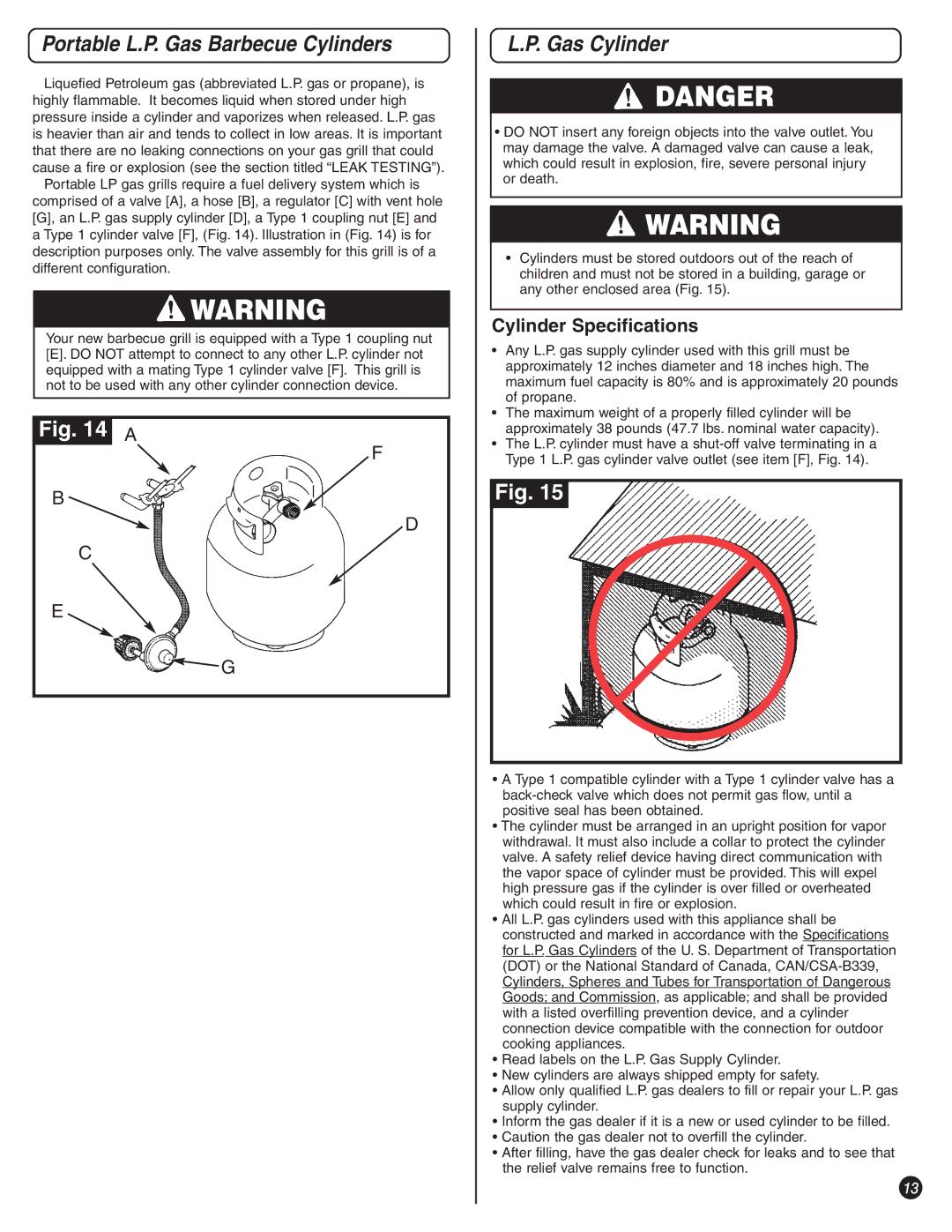
Portable L.P. Gas Barbecue Cylinders
Liquefied Petroleum gas (abbreviated L.P. gas or propane), is highly flammable. It becomes liquid when stored under high pressure inside a cylinder and vaporizes when released. L.P. gas is heavier than air and tends to collect in low areas. It is important that there are no leaking connections on your gas grill that could cause a fire or explosion (see the section titled “LEAK TESTING”).
Portable LP gas grills require a fuel delivery system which is comprised of a valve [A], a hose [B], a regulator [C] with vent hole [G], an L.P. gas supply cylinder [D], a Type 1 coupling nut [E] and a Type 1 cylinder valve [F], (Fig. 14). Illustration in (Fig. 14) is for description purposes only. The valve assembly for this grill is of a different configuration.
![]() WARNING
WARNING
Your new barbecue grill is equipped with a Type 1 coupling nut
[E].DO NOT attempt to connect to any other L.P. cylinder not equipped with a mating Type 1 cylinder valve [F]. This grill is not to be used with any other cylinder connection device.
Fig. 14 A
F
B
D
C
E
![]() G
G
L.P. Gas Cylinder
![]() DANGER
DANGER
•DO NOT insert any foreign objects into the valve outlet. You may damage the valve. A damaged valve can cause a leak, which could result in explosion, fire, severe personal injury or death.
![]() WARNING
WARNING
•Cylinders must be stored outdoors out of the reach of children and must not be stored in a building, garage or any other enclosed area (Fig. 15).
Cylinder Specifications
•Any L.P. gas supply cylinder used with this grill must be approximately 12 inches diameter and 18 inches high. The maximum fuel capacity is 80% and is approximately 20 pounds of propane.
•The maximum weight of a properly filled cylinder will be approximately 38 pounds (47.7 lbs. nominal water capacity).
•The L.P. cylinder must have a
Fig. 15
•A Type 1 compatible cylinder with a Type 1 cylinder valve has a
•The cylinder must be arranged in an upright position for vapor withdrawal. It must also include a collar to protect the cylinder valve. A safety relief device having direct communication with the vapor space of cylinder must be provided. This will expel high pressure gas if the cylinder is over filled or overheated which could result in fire or explosion.
•All L.P. gas cylinders used with this appliance shall be constructed and marked in accordance with the Specifications for L.P. Gas Cylinders of the U. S. Department of Transportation (DOT) or the National Standard of Canada,
•Read labels on the L.P. Gas Supply Cylinder.
•New cylinders are always shipped empty for safety.
•Allow only qualified L.P. gas dealers to fill or repair your L.P. gas supply cylinder.
•Inform the gas dealer if it is a new or used cylinder to be filled.
•Caution the gas dealer not to overfill the cylinder.
•After filling, have the gas dealer check for leaks and to see that the relief valve remains free to function.
13
